The Ohio-based artist Julia Christensen talks to Gabrielle Schwarz about how a visit to an e-waste processing centre in India sparked an obsession with our throwaway culture, and how that has fed into a book and an exhibition titled ‘Upgrade Available’.
Your current work explores what you call ‘upgrade culture’. Can you explain what you mean by this term – and how you became interested in what it represents?
The concept that I’m working with, what I call ‘upgrade culture’, is this sort of relentless notion that we constantly have to upgrade our electronics and media to remain relevant. I became interested in this, how this was culturally happening, because I visited, by a crazy chain of events, an e-waste processing centre in India several years ago. It was the first time I was faced with this global aggregate of e-waste, mountains of old computers and printers, etc. As a member of the consumer public I just had never thought about what happens when I take my computer to the recycling centre to be recycled.
And of course I’m a media artist. I use a camera, I have a phone. I am part of this whole thing, so I began to think critically about what it means [to participate in upgrade culture]. It’s hard to connect the little phones in our pockets to this larger global issue, which is what it is. We are enacting a planetary crisis right now with electronics.
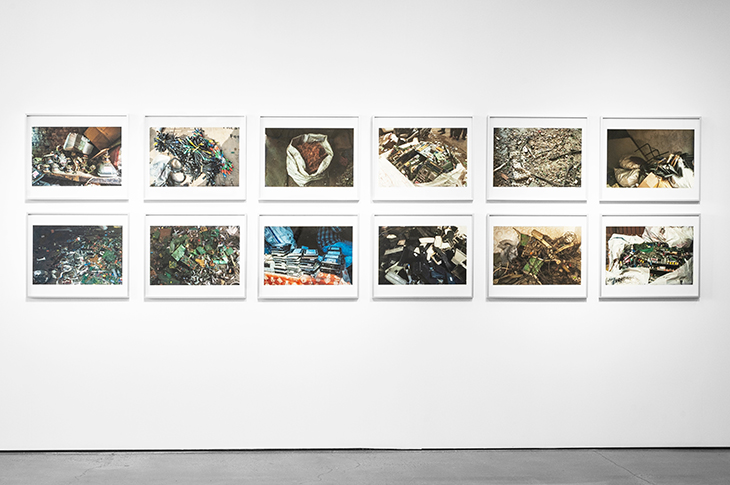
Installation view of ‘Julia Christensen: Upgrade Available’, Mullin Gallery, ArtCenter College of Design, Pasadena
What are some of the things you learned about the e-waste industry during this time?
This is a relatively new issue, and so there are no international laws: policies are different from country to country. Even the definition of electronics or e-waste, or recycling, varies enormously. That’s part of what makes it so hard to create new conventions and policies that will curb the problem.
The first e-waste centre that I visited in India was within a municipal export zone, and so that meant the trash was imported, it was mined for the precious metals, and then everything else had to be exported, and where it was exported to is a question mark. I don’t know, but we assume landfills in China. There are watchdog groups like Toxic Link [in New Delhi] that will do research to track how that happens, but there are also lots of questions.
Your project encompasses photographic series in which you record the results or the residue of upgrade culture – from e-waste facilities to personal collections of VHS tapes. On the face of it these seem like very different subjects…
Through the course of this project I visited these e-waste processing centres, but then I also was interested in looking at obsolete media that friends and neighbours had stored in their basements. I wound up working with institutional archives at the Los Angeles County Museum of Art [LACMA], which has every possible media format from the last 50 years packed up in boxes in a big room.
So I began photographing those collections as well, thinking about how the same piece of media – a VHS tape from the ’80s – in one context is in a landfill, in another context is in a basement and possibly going to be passed down to the next generation, and then in another context is a work of art that’s being held in an archive. I was interested in how these contexts change the [object’s] economic and cultural value. The photographs in the exhibition juxtapose them. There’s one wall of the e-waste, then there’s one wall of the personal collections and then there’s one wall of the institutional archives, and it’s the same stuff. There’s also a formal contrast: the stacked VHS tapes have got so much space around them as opposed to the images of the e-waste facilities, which are a big mess.
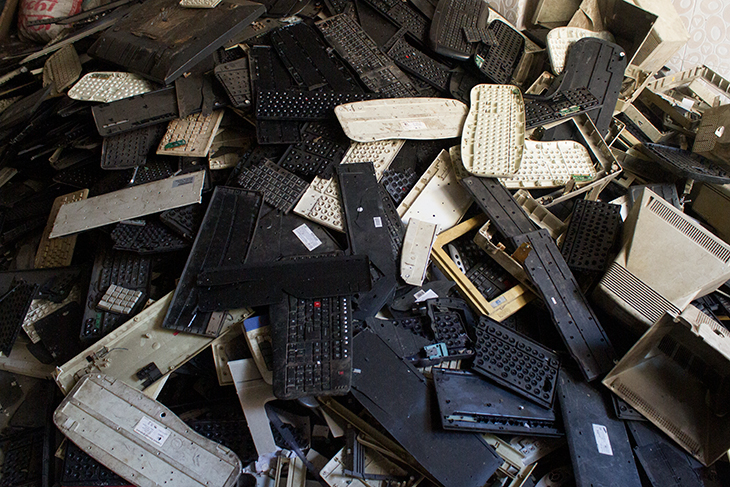
Keyboard Parts, Mustafabad Market (Delhi, India) (2015), from the series Technology Time (2011–ongoing), Julia Christensen. Photo: courtesy the artist
Did your time in the archives at LACMA get you thinking about how your own work might be preserved?
Yes, absolutely. That is a running theme throughout the book and the entire project: this idea that we engage with photographs and slides and recordings with a vague idea that they will outlast us, but that is by no means an empirical certainty. Just seeing these generations of old media formats, many of which simply cannot be accessed again – or if they are accessible, it takes a huge amount of time and money and experts – puts into context our digital lives today. There is this idea that people can make a photo album on Facebook and there it is, there’s the photo album, but in reality that’s proprietary memory on a server far, far away that doesn’t belong to us, and can be shut down at any time. This disconnect between the reality of what we want and the corporate structures that we’re working within, that is kind of the question I’m interested in.
In terms of my own work, this is an ongoing question for artists who work with these media. What is the legacy artwork? Will it become something else when it’s transferred to another media format? And very often the answer is: yes, it will. I mean we don’t know for sure. We’ll see what kinds of trends emerge in terms of preserving artworks that are made with proprietary digital media.
On a material level at least, your work seems to resist this process of erasure…
It’s different with different projects. In this show [at ArtCenter, Pasadena] I have drawings [We Share Our Pictures, a series of ink drawings on archival paper] […] The photographs are all digital photographs, so there’s a digital file, but they’re also printed as physical objects. And then I have a flat file over here full of brochures and posters and ephemera, from shows and that kind of thing.
When I discovered the process of making a book about an art project, it became a key way that I like to work, a way of preserving not only the works, but also the stories and the ideas behind them. This [Upgrade Available] is my second book. The first was called Big Box Reuse, and it was about the civic reuse of abandoned Walmart and K-Mart buildings throughout the United States. I documented and made all of this artwork for years about communities reusing abandoned Big Box buildings as churches and schools and hospitals. And with Upgrade Available, this work has unfolded over the last 10 years with this driving question about what upgrade culture is, how it impacts on life in these different ways, and it makes so much sense in that format. We worked with a designer, Filiep Tacq, who’s in Belgium, and he was interested in asking things like: what material can we use for the cover that will age gracefully and will feel nice in 20 years?
You’ve mentioned the corporate structures that are in many ways to blame for upgrade culture. Can you talk a bit more about your work addressing the idea of planned obsolescence?
One of the pieces in the show is called Burnouts and it’s an installation built of outdated iPhones and iPads. In some cases their screens are projected, but in this installation they’ll be on the wall. There are 12 of them. They are displaying animations I made of constellations in the night sky that have been retired from star maps. There are times when the International Astronomical Union determines certain constellations are no longer relevant to our study of the night sky, because oftentimes it’s gotten too bright on earth to see them anymore.
So the stars are still there. They’re still shining in the sky, but we’ve determined that they’re irrelevant to us now, and I thought that it was a good homage to pay to them to make these iPhones and iPads – which are also still totally functional, but we’ve determined they’re no longer culturally relevant – display these constellations.
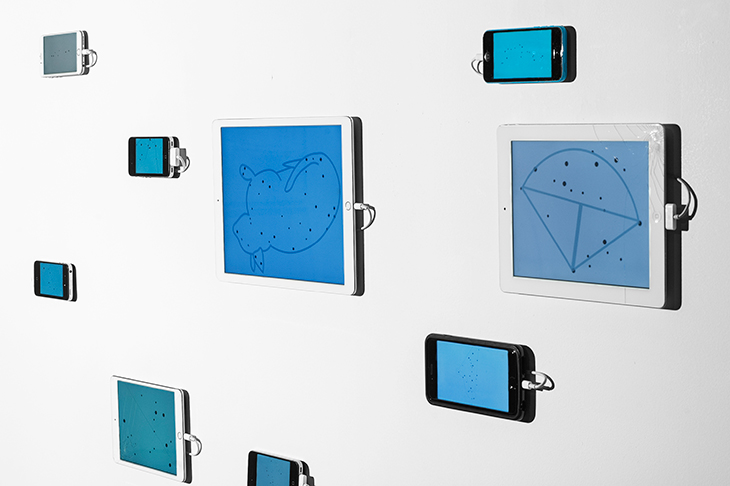
Installation view of ‘Julia Christensen: Upgrade Available’, Mullin Gallery, ArtCenter College of Design, Pasadena
Another aspect of the exhibition and the book is your work with NASA and the Jet Propulsion Lab (JPL), looking to create some kind of technology with a longer lifespan. How did you become involved with them?
I have a fellowship at LACMA’s Art + Technology Lab, and through that fellowship, I was introduced to scientists and engineers at a number of southern California-based companies, including SpaceX and Google and JPL, which is based in Pasadena. I was years into the research about upgrade culture and the person I was talking with had been involved in conversations about a spacecraft that, in order to complete its mission, would need to operate for decades. They were talking about a mission concept that would go to Proxima b, which is the closest exoplanet in the Alpha Centauri star system, 42 light years away. It’s estimated that the spacecraft won’t be ready until round about 2069 – 100 years after the Apollo 11 mission. So the idea is this spacecraft leaves in 2069 and then arrives at Proxima b in 2111, creating the question: what kind of technology do we design now that will need to send us back data that we can process some 40-odd years later?
And what did you come up with?
They invited me to envisage an art piece that would be embedded on this future spacecraft to Proxima b, and I began questioning the value of putting a human-made artwork on this spacecraft, simply because it’s not our planet and in a hundred years there are species that will still be alive that are alive now, and I won’t be. I came to this idea of creating ‘songs of trees’ to embed on this future spacecraft. We used that as a prompt to build a system in which we could potentially capture the song of the tree for 200 years, and this gave us an opportunity to think about building a spacecraft that would be in low-earth orbit for longer than six months or a year, which is how long these things are usually designed to operate.
So we are designing a 200-year CubeSat [a miniaturised satellite] that will be in low-earth orbit, and we are harnessing a set of trees on earth, living trees, to act as mega-antennae that can communicate with this CubeSat, and we’re collecting data about the health of the trees, about the operational health of the CubeSat, and ‘sonifying’ that data so it turns into a song. The satellite and the trees will be passing that data back and forth, singing in a duet for centuries, and that song will be embedded on future spacecraft to tell a story of life on earth.
‘Julia Christensen: Upgrade Available’ is at the Peter and Merle Mullin Gallery, ArtCenter College of Design, Pasadena, until 20 December.
Unlimited access from just $16 every 3 months
Subscribe to get unlimited and exclusive access to the top art stories, interviews and exhibition reviews.

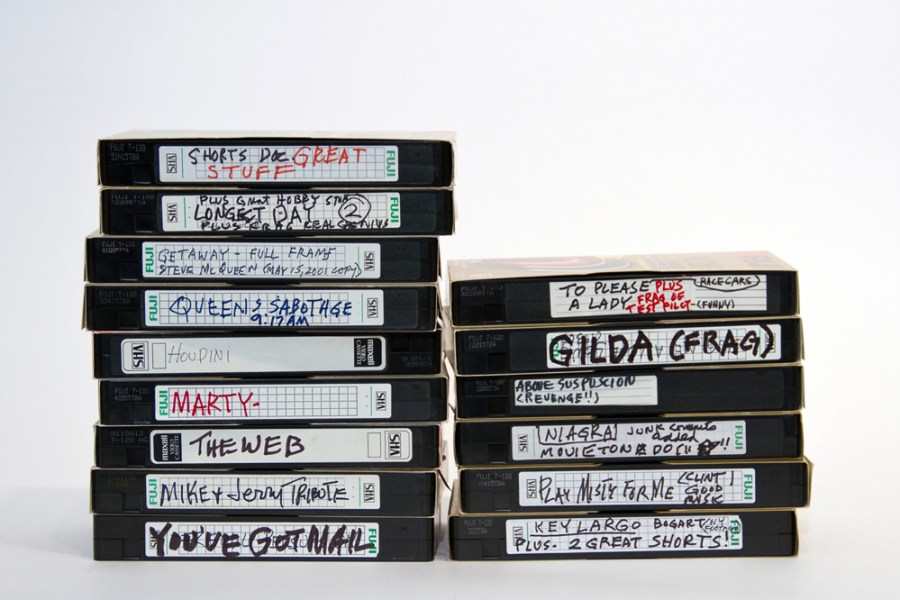
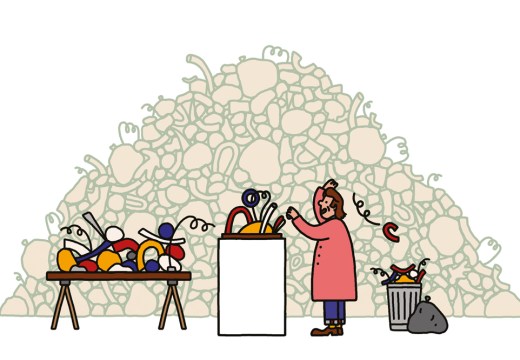
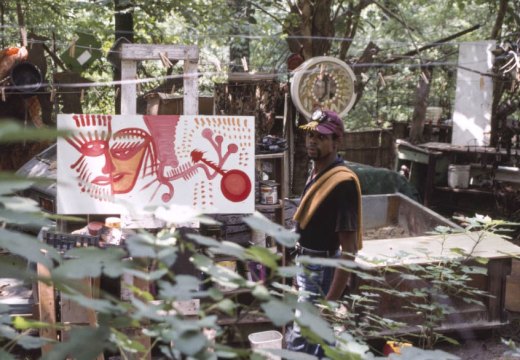










![Masterpiece [Re]discovery 2022. Photo: Ben Fisher Photography, courtesy of Masterpiece London](http://www.apollo-magazine.com/wp-content/uploads/2022/07/MPL2022_4263.jpg)
It’s time for the government of London to return to its rightful home